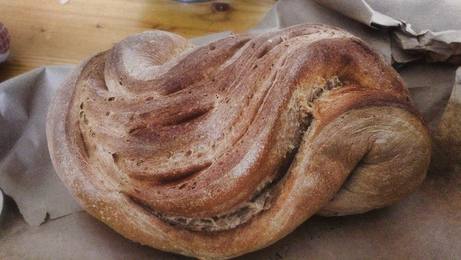This post originally appeared at Churchwork.com
by Nurya Love Parish
Most clergy and lay leaders are preoccupied on some level with two very practical, 21st-century church questions:
1) Younger generations are not participating in church as we know it. What can we do differently that might work better to engage millennials in discovering and living the gospel?
2) The financial models of church as we know it all depend on active participation of older generations. What financial model for the church will allow for viable faith communities when the “Silent” generation is no longer funding the operating budget?
Some are also preoccupied with an even more pressing question:
3) The way we live on this planet is not sustainable. How can the church help forge a different path?
Yesterday I stumbled upon a way of being church that answers all three questions. It seemed so important that I broke a long blog silence to jump back in and tell you about it. (I’ve had a lot going on; it’s all good; I’ll tell you more soon.)
Yesterday I spoke to the Rev. Zach Kerzee, the founder of Simple Church.
Here’s his story in a nutshell:
I was in my third year of my M.Div. program when I was approached by the New England Conference of the United Methodist Church and asked to consider being a church planter. The conference wanted to plant a new church in Grafton, Massachusetts where two Methodist churches had merged and then the merged church had closed. The conference had sold the church building but kept the parsonage. They pledged a start-up budget from the sale of the church building and the parsonage to live in. This was in spring of 2014.
I had been part of Thursday night dinners at divinity school with wine and good food and theological conversation until two in the morning, and I wanted a church like that. I wanted a simple church focused on simplicity as a guiding principle. So I decided to start a church centered around food.
When I got to Grafton I learned that the parsonage was on five acres of land next to an organic farm. I started working at the farm just to learn. Farming was not in the plan until I saw the location. But they paid me in vegetables which we used for the meals. We called the new church Simple Church and we met on Thursday evenings as a dinner church. We started in the basement of the parsonage in fall of 2014. Local media did a good article about us so we got the word out really well and started with about 25 people. We grew out of the parsonage and into the fellowship hall of a UCC church. But during the winter our numbers went down. We also were realizing we didn’t want to completely depend on donations from members for our financial stability. We asked ourselves how we would be able to sustain our $80,000 budget if we were a small church of 40 people?

We looked to the old monastic traditions, where the community supported itself through making something to sell. We asked ourselves what we could make, and we noticed that there was no fresh bread bakery in Grafton. I never baked a loaf of bread before last year but YouTube is a great teacher. Because we could use the kitchen of the UCC church and raw ingredients weren’t expensive, starting a bakery seemed possible. We went through all the licensing requirements in winter 2014 and started baking for farmer’s markets in spring 2015. We started at country stores, but then we realized that selling at farmer’s markets would give us a natural way to connect in the community. I had been knocking on doors to try to meet people, but at farmer’s markets people would come to us.
At the beginning it was me in the kitchen with two Methodist church ladies. We started with 10 loaves per baking session. Now we are up to 50 loaves per baking session. We bake two days a week and sell at farmer’s markets two days a week. We just started a youth apprenticeship program so young people are helping with the bread baking. We also sell eggs and pies. We invite every person who buys from us to come to church. Our growth in the church has come from two places: people who invite their friends, and people who meet us at the farmer’s market.
Our congregation, when everybody comes, is now about 50 people. About a third of them are millennials. Another third are parents and their children. The last third are older people who mostly belonged to the churches that closed. Two-thirds of the congregation wasn’t participating in any kind of church before we came along. About a third of the congregation attends another church for Sunday morning worship.
Last month we brought in $5,000: half of that came from our farmer’s market sales and half of it came from donations at church. We are starting to feel hopeful that this is working. It is looking like a successful experiment. The Methodists have more funding available through sales of church buildings, but we don’t want to take it for ourselves. We are starting a fellowship program for someone to come alongside us for a year and learn what we do, then start the second Simple Church.
I feel like the church right now is not trying new things. We are trying to make millennials come back to the way it was and I don’t think that is going to work. Somebody has to look foolish and risk failure trying a new thing. It might as well be me.
I tried a bunch of new things. I knew some of them might fail and if they did I would look foolish. But I decided if I was going to look foolish, I would rather look foolish for the Gospel.
Here are my takeaways from this narrative:
Empowering younger generations with actual funding matters. Simple Church would not exist if Zach Kerzee’s first job out of seminary had been with an existing congregation. Millennials and Generation X are drastically underrepresented in church leadership bodies, especially committees who decide about funding. Boomers and Silents need to recognize that we are the generations who will discover the ways of being church that fit for our generations, and support those of us who are trying new things, looking foolish and risking failure for the sake of the Gospel. Our biggest challenge is finding funding for the time it takes to start new things before they can become self-supporting. Meanwhile, the established church is sitting on millions of dollars while wondering how to reach younger generations.
The old ways still work. Zach Kerzee didn’t invent raising money for ministry through selling a product to the public. This is a very old monastic model which deserves a new look in our financial times.
Pastors and judicatory leaders have to recognize when it is time to take a risk. It was a huge risk for the Methodists to fund a 25-year-old freshly minted M.Div. to start a completely new church. On the other hand, everything they had already tried in Grafton had failed. The churches that existed had closed. Were they going to close up shop and leave town, or were they going to decide that Jesus Christ still had work to do in Grafton and they were called, with their resources, to be part of that work in a new generation? It was time to take a risk and they took one.
Just like the Presbyterians, the Methodists are way, way ahead of the Episcopalians. The Presbyterians have the 1000 worshipping communities initiative. The Methodists have Path 1 – and a national church planting conference that is free to the first 100 people who register. What do we Episcopalians have? We’ll find out after we learn how the recently approved funds for church planting are being administered by our new leaders. So far, we don’t have anything like either of those programs.
Pray for Simple Church and Zach Kerzee. It is no small thing to go from being a newly minted minister to being one of the subjects of a glowing New York Times article in less than 18 months. Pray that God continues to work through their ministry. Pray that Zach gets a chance at respite and renewal. Pray that this ministry continues to bear fruit for the gospel. Pray that it will not inspire slavish imitation on the details, but rather inspire others to be willing to risk looking like fools for Jesus.
Got a “new thing” on your mind? How does this story inspire you?


